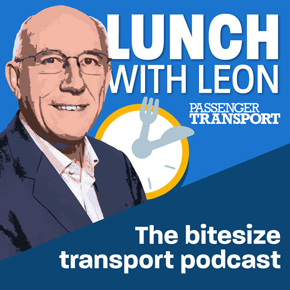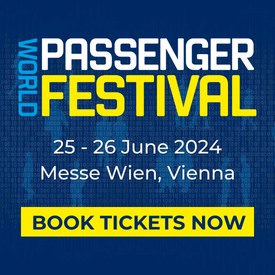Brent Toderian, a passionate advocate of public transport, spoke at this month’s CPT Scotland Conference. Robert Jack reports

Brent Toderian is an internationally renowned practitioner and thought leader on city planning and transport, consulting on cities and projects across the globe.
He set up his own consultancy business, TODERIAN UrbanWORKS, in 2012 following six years as chief planner for the Canadian city of Vancouver, a globally renowned multi-modal city by design. He has twice been voted among the most influential global urbanists of all time by Planetizen.
Toderian is a combative and energetic campaigner for public transport – or transit as it is known in North America – and active travel. He has accumulated 152,000 followers on X/Twitter (@BrentToderian), where he promotes a vision of less car dependent cities.
Earlier this month, he addressed the CPT Scotland Conference in Glasgow via a video link in a session chaired by Ralph Roberts, CEO of bus group McGill’s and the current president of CPT UK. And here are five of his key messages:
Buses are ‘extremely sexy’
“I often say buses are the completely sexy unsung heroes of urban transportation and thus urban city building,” said Toderian.
“And I say ‘completely sexy’ because for a long time, you know, folks like me used to say, ‘well buses aren’t sexy, not like light rail or heavy rail or or other higher order levels of transit, so to speak’. But I’ve stopped saying that because buses are extremely sexy to me, because they are about as flexible, cost-efficient etc as you can get in terms of a form of public transit.”
He accepted that many people won’t share his enthusiasm and conceded that work needed to be done on improving their reputation. And the best way to do this, he argued, is to get them to run on time.
We can do a lot of bells and whistles for a better bus service,” he said, “but the key is that they need to be predictable.
“We can do a lot of bells and whistles for a better bus service,” he said, “but the key is that they need to be predictable.”
However, he argued that a reliable service won’t appeal to users if it’s infrequent: “If your buses are running every 45 minutes and they’re running on time, that’s still a lousy bus service.”
There’s no ‘battle’ with motorists
Toderian believes that public transport and active travel “are critically important to the operation and good planning and success of cities and city regions”.
“I think that’s our starting point and end point for public conversations about public transit,” he said.
“What I often say to cities, and to city leaders is, whether you care about public transit or not, whether you ever ride public transit or ever intend to ride public transit or not, your life, your existence in our urban societies and our suburban societies, is critically connected to bus being very attractive, public transit being very attractive, to other people. Because if you’re a driver and you always intend to a drive, the best thing you can hope for is public transit being as attractive as possible.”
The day before Toderian addressed the CPT Scotland Conference, the UK Government had launched its Plan for Drivers – a “new 30-point plan to support people’s freedom to use their cars and curb over-zealous enforcement measures”.
We need to be able to have a conversation about public transit that stops pitting driving versus public transport or active transport – something your prime minister in the UK needs to understand
“We need to be able to have a conversation about public transit that stops pitting driving versus public transport or active transport – something your prime minister in the UK needs to understand,” said Toderian.
“We are not in a battle of motorists versus bus riders, or motorists versus walkers or bike riders. We’re all in this together and the better that walking, biking and public transport works, the better the city and the city region works for everyone – including drivers.
“Anything other than that either doesn’t understand how cities work or is just trying to make you angry to, hopefully, get your vote or your clicks on social media.”
We need ‘plangineers’
“One of the lines we’ve said in Vancouver for a long time is the best transportation plan is a great land use plan,” said Toderian.
“In other words, your land use decisions, particularly in your suburbs, which usually have poor land use decisions that lead to car dependency … are the bedrock of your success in public transport, and your success in active transport – walking and biking, scooters etc.”
He continued: “Here in Vancouver we use a term called ‘plangineer’, which is a term we used when we did the transportation plan in the late 1990s, which recognises that city planners, land use planners particularly, and transportation engineers, have one common definition of success – which is to make a better city.
“And so land, use planning and transportation infrastructure planning have to be planned together so that you get optimal success.”
In much of the world, there has been a separation of these disciplines. The result is that decision making on land use and transport infrastructure is not aligned.
I often say, if you get your land use wrong it’s very hard to get your transportation infrastructure right
“I often say, if you get your land use wrong it’s very hard to get your transportation infrastructure right because you just end up spending a lot of money on infrastructure connecting nothing with nothing over long distances,” Toderian explained.
Once the land use planning is aligned with transport planning it’s possible to create attractive public transport options, by using bus lanes or by providing Bus Rapid Transit.
“I you’re stuck in the same traffic as the cars there’s very little impetus for mode shift – in other words, doing trips by bus instead of trips by cars,” he said, “and you end up with buses being the last resort … Bus Rapid Transit, the ability to by-pass the congestion, is probably the single most important things that cities can do to facilitate ridership post-pandemic.”
Ridership is the ‘Holy Grail’
As the most flexible mode of transport, there is pressure on buses to serve as wide an area as possible, requiring resources to be reallocated from dense, higher frequency corridors to lower density suburbs. This trade off is sometimes framed as being a conflict between socialists (who want a service for everyone) and capitalists (who prioritise profit). He believes that this is a false narrative.
“I have thought for a long time that we have the entirely wrong conversation about this choice,” said Toderian. “I am not shy in saying to cities that in a climate emergency, in an affordability emergency, when we are assembling land use and housing density in ways that can specifically facilitate ridership, through transit-oriented development … we need the routes and the bus frequency to match those land use decisions.
Ridership has to be our priority, and this is not a capitalist versus socialist perspective. This is a very pragmatic, non-political, ‘how cities work’ kind of perspective
“Ridership has to be our priority, and this is not a capitalist versus socialist perspective. This is a very pragmatic, non-political, ‘how cities work’ kind of perspective.”
He acknowledges that this can be a tough decision, but he advises cities to emphasise ridership over coverage.
“Ridership is the Holy Grail … We need fewer car trips, more public transit trips,” he argued. “I constantly remind decision-makers that every transit trip actually benefits society in every way, including financially, because it doesn’t matter if transit pays for itself because transit provides an economic good to the city region, because car trips are heavily, heavily subsidised and bus transit trips are not. And so the more we get people riding buses, and walking and biking obviously, the better it is financially, economically, climate-wise, affordability-wise etc.”
He added: “That is not a capitalist perspective, that is a public interest perspective. And so, when I’m working with cities and city regions, I’m trying to blow up this false narrative of capitalist versus socialist.”
Finally, Toderian maintained that a strategy of focusing resources on ridership can actually lead to improved coverage.
‘Tension is unavoidable’
Toderian said that tension was unavoidable when pushing for changes that support public transport and active travel. He uses social media and mainstream media to make the case for change. And he’s not afraid to lock horns with those who declare that there is a “war on the motorist”.
“I use my Twitter feed to constantly beat the drum of how we need to fundamentally rethink how we think about public transport in our cities, and this whole fake narrative of drivers versus transit riders,” he said.
“I believe in social media. I believe in mainstream media. I believe in being less mind-numbingly boring than we usually are when we talk about these kinds of subjects, so that the public and the politicians actually pay attention and the media pays attention.
“Because we do need to break through the noise, break through the car advertisements … and actually inform the public in interesting and memorable ways about the truth about how cities work and how public transit works.”
In addition to running a busy consultancy practice, Toderian devotes a lot of time to trying to influence public opinion.
We need to have a much more interesting and provocative conversation and court the controversy in order to actually blow holes in the myths
He continued: “We need to have a much more interesting and provocative conversation and court the controversy in order to actually blow holes in the myths, etc, so that the politicians have better information and we can call BS on them when they’re doing clearly the wrong thing when they should know better.
“I often say knowing the right decisions is the easy part, actually getting the public to understand why it’s the right decision and getting the decision makers to make the right decision, even when it’s controversial, that is the hard part, and that is the part that we need to be much better at and spend more time at.”
Toderian has clients who want a conversation but don’t want to be controversial. His response is to tell them that this is impossible.
“I don’t know how to actually effect change without having a tension-filled, controversial conversation,” he said.
He said that he begins every conversation by talking about the five crises that our cities face: the climate crisis, the housing/affordability crisis, the public infrastructure cost crisis, the social equity/racism/classism crisis, and the public health crisis.
“These are the burning platforms … that show us that the status quo is not working,” he said. “And in the context of a five crisis era, coming out of a pandemic, if we still have the wrong ideas, and they’re doing the wrong things, then shame on us.”
This article appears in the latest issue of Passenger Transport.
DON’T MISS OUT – GET YOUR COPY! – click here to subscribe!









